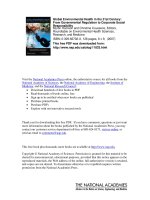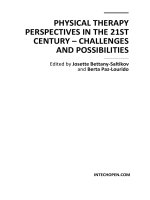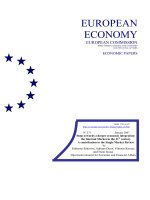PHYSICAL THERAPY PERSPECTIVES IN THE 21ST CENTURY – CHALLENGES AND POSSIBILITIES potx
Bạn đang xem bản rút gọn của tài liệu. Xem và tải ngay bản đầy đủ của tài liệu tại đây (17.62 MB, 398 trang )
PHYSICAL THERAPY
PERSPECTIVES IN THE 21ST
CENTURY – CHALLENGES
AND POSSIBILITIES
Edited by Josette Bettany-Saltikov
and Berta Paz-Lourido
Physical Therapy Perspectives in the 21st Century – Challenges and Possibilities
Edited by Josette Bettany-Saltikov and Berta Paz-Lourido
Published by InTech
Janeza Trdine 9, 51000 Rijeka, Croatia
Copyright © 2012 InTech
All chapters are Open Access distributed under the Creative Commons Attribution 3.0
license, which allows users to download, copy and build upon published articles even for
commercial purposes, as long as the author and publisher are properly credited, which
ensures maximum dissemination and a wider impact of our publications. After this work
has been published by InTech, authors have the right to republish it, in whole or part, in
any publication of which they are the author, and to make other personal use of the
work. Any republication, referencing or personal use of the work must explicitly identify
the original source.
As for readers, this license allows users to download, copy and build upon published
chapters even for commercial purposes, as long as the author and publisher are properly
credited, which ensures maximum dissemination and a wider impact of our publications.
Notice
Statements and opinions expressed in the chapters are these of the individual contributors
and not necessarily those of the editors or publisher. No responsibility is accepted for the
accuracy of information contained in the published chapters. The publisher assumes no
responsibility for any damage or injury to persons or property arising out of the use of any
materials, instructions, methods or ideas contained in the book.
Publishing Process Manager Maja Jukic
Technical Editor Teodora Smiljanic
Cover Designer InTech Design Team
First published April, 2012
Printed in Croatia
A free online edition of this book is available at www.intechopen.com
Additional hard copies can be obtained from
Physical Therapy Perspectives in the 21st Century – Challenges and Possibilities, Edited by
Josette Bettany-Saltikov and Berta Paz-Lourido
p. cm.
ISBN 978-953-51-0459-9
Contents
Preface IX
Part 1 Physical Therapy for Scoliosis and Spinal Deformities in
Infants, Adolescents and Adults 1
Chapter 1 Physical Therapy for Adolescents with Idiopathic Scoliosis 3
Josette Bettany-Saltikov, Tim Cook, Manuel Rigo,
Jean Claude De Mauroy, Michele Romano, Stefano Negrini,
Jacek Durmala, Ana del Campo, Christine Colliard,
Andrejz M'hango and Marianna Bialek
Chapter 2 Kyphosis Physiotherapy from Childhood to Old Age 41
Jean Claude de Mauroy
Chapter 3 A Review of Non-Invasive Treatment Interventions
for Spinal Deformities 67
Clare Lewis
Part 2 Physical Therapy for Biomechanical and
Musculoskeletal Conditions 89
Chapter 4 An Overview on the Efficacy of
Manual Therapy (Manipulations and Mobilisations)
on Nonspecific Cervical Pain:
A Systematic Review in Adults 91
José Antonio Mirallas Martínez
Chapter 5 Use of Physiotherapeutic Methods to Influence
the Position of the Foot 107
Eva Buchtelová
Chapter 6 Effectiveness of Passive Joint Mobilisation for
Shoulder Dysfunction: A Review of the Literature 125
Judy Chen
VI Contents
Part 3 Use of Cryotherapy and Thermotherapy
in Physical Therapy 153
Chapter 7 Cryotherapy: Physiological Considerations
and Applications to Physical Therapy 155
Anna Lubkowska
Chapter 8 Natural Wool Fabrics in Physiotherapy 177
Krzysztof Gieremek and Wojciech Cieśla
Part 4 Characteristics of Physical Therapy Interventions with
Elderly Patients at Home and Within Clinical Settings 195
Chapter 9 Home Physiotherapy: The Relevance of Social Determinants
of Health in the Development of Physiotherapy
in the Home Environment 197
Berta Paz-Lourido
Chapter 10 Functional Challenges in the Elderly 219
A. C. Tavares and G. V. Guimarães
Chapter 11 Evidence-Based Management in the Rehabilitation of
Osteoporotic Patients with Fragility Fractures 233
Umberto Tarantino, Irene Cerocchi, Federico Maria Liuni,
Pietro Pistillo, Cecilia Rao and Monica Celi
Part 5 Effects of Psychological Factors, Body Awareness
and Relaxation Techniques in
Physical Therapy Interventions 249
Chapter 12 Focus on Psychological Factors and Body Awareness in
Multimodal Musculoskeletal Pain Rehabilitation 251
G. Gard
Chapter 13 Relaxation Techniques and States –
Applications to Physical Therapy 263
Leslaw Kulmatycki
Part 6 Physical Therapy Interventions in Patients with Respiratory
and Cardiovascular Disorders 281
Chapter 14 Effect of Inspiratory Muscle Training on Weaning Success in
Critically Ill Intubated Patients 283
Samária Cader, Rodrigo Vale and Estélio Dantas
Chapter 15 Lipedema 305
Győző Szolnoky
Contents VII
Part 7 Physical Therapy for Patients with Stroke 313
Chapter 16 Running a Complementary Stroke Rehabilitation
and Aftercare Program:
Experiences of Four European Centres 315
Wilfried Schupp, Napasakorn Komaratat
and Simon Steib
Chapter 17 Group Circuit Class Therapy for Stroke Survivors -
A Review of the Evidence and Clinical Implications 337
Coralie English, Ingrid van de Port and Elizabeth Lynch
Part 8 Physical Therapy and New Concepts of
Wheelchair Design 369
Chapter 18 Reaching for Independence: Challenges for
a New Concept of Wheelchair Design 371
Fausto Orsi Medola, Carlos Alberto Fortulan,
Carla da Silva Santana and Valeria Meirelles Carril Elui
Preface
We are very excited to introduce the first InTech book dedicated to advancements in
the field of physical therapy. Indeed in the last few decades physical therapists have
made great strides in advancing both the research knowledge base within physical
therapy whilst at the same time making significant improvements in clinical practice.
In our society today physical therapists face continuous challenges related to the
advancement of physical therapy practice, medicine and technology in addition to the
effects of the global economic downturn. An ongoing challenge for the profession is
the need to underpin physical therapy practice with the best available evidence. For
the past five decades, physical therapy has been a burgeoning science as evidenced by
the numerous national and international physical therapy organisations to be found
worldwide.
The aim of this book is not to cover all areas of research and practice in physical
therapy. There are many emerging contexts that require the intervention of physical
therapists and it is not possible to include all of them within a limited space. We
consider that this book highlights a number of key aspects related to the way that
physical therapy is currently contributing to better overall health of citizens
everywhere who are suffering from numerous diverse medical conditions. Because of
this, different topics and research approaches will be found within this book, ranging
from very specific interventions to broader concepts within physical therapy practice
that consider the social determinants of health.
As this book will demonstrate, many researchers throughout the world are
contributing greatly to our understanding of the use of a range of diverse physical
therapy approaches for a wide array of medical conditions. More recently, increasing
and innovative contributions have been made by physical therapists worldwide
towards this important enterprise. They are also providing strong evidence to support
the benefits of exercise to both avoid and treat acute and chronic diseases.
This book contains new information on physical therapy research and clinical
approaches that are being undertaken into numerous medical conditions;
biomechanical and musculoskeletal conditions as well as the effects of psychological
factors, body awareness and relaxation techniques; specific and specialist exercises for
X Preface
the treatment of scoliosis and spinal deformities in infants and adolescents; new
thermal agents are being introduced and different types of physical therapy
interventions are being introduced for the elderly both in the home and clinical setting.
Additionally research into physical therapy interventions for patients with respiratory,
cardiovascular disorders and stroke is being undertaken and new concepts of
wheelchair design are being implemented.
Our hope is that this book will become an important compendium and resource for
physical therapists who treat a wide array of clinical conditions. Additionally, we hope
these reviews will act to stimulate researchers throughout the world to continue this
important work and solve persistent clinical questions posed by physical therapy
researchers and clinicians worldwide.
Dr. Josette Bettany-Saltikov
Teesside University, Middlesbrough
UK
Dr. Berta Paz-Lourido
University of the Balearic Islands
Spain
Part 1
Physical Therapy for Scoliosis
and Spinal Deformities in
Infants, Adolescents and Adults
1
Physical Therapy for Adolescents
with Idiopathic Scoliosis
Josette Bettany-Saltikov
1
et al.
*
1
Teesside University, Middlesbrough,
1,2
UK
1. Introduction
Scoliosis is a three-dimensional deformity of the spine. In its most common form,
idiopathic scoliosis (70% to 80% of cases), the causes are unknown (Rowe 2003). AIS is
discovered at 10 years of age or older, and is defined as a curve of at least 10°, measured
on a standing radiograph using the Cobb technique (Parent et al, 2005). While the
prevalence of AIS is around 3% in the general population, almost 10% of those diagnosed
with AIS will require some form of treatment; usually observation or scoliosis-specific
exercises (SSE) for mild curves, braces for moderate curves and spinal surgery for severe
curves (Cobb angle >50
0
). Up to 0.1% of the population is at risk of requiring surgery
(Lonstein, 2006). A severe form of AIS is more commonly found in females. Typically, AIS
does not cause any health problems during growth (except for extreme cases). However,
the resulting surface deformity frequently has a negative impact on adolescents` body-
image and self-esteem that can give rise to quality of life (QoL) issues and in worst cases,
psychological disturbances (Maclean et al, 1989). Adolescent patients are generally treated
in an attempt to halt the progressive nature of the deformity. No treatments succeed in
full correction to a normal spine, and even reduction of the deformity is difficult
(Danielson and Nachemson, 2001). If scoliosis surpasses a critical threshold, usually
considered to be 30º Cobb, at the end of growth, the risk of health and social problems in
adulthood increases significantly (Negrini, 2005). Problems include reduced quality of
life, disability, pain, increased cosmetic deformity, functional limitations, sometimes
*
Tim Cook
2
, Manuel Rigo
3
, Jean Claude De Mauroy
4
, Michele Romano
5
, Stefano Negrini
5
,
Jacek Durmala
6
, Ana del Campo
2
, Christine Colliard
2
, Andrejz M'hango
7
and Marianna Bialek
7
1
Teesside University, Middlesbrough, UK
2
SpineCorporation, UK, Spain
3
Elena Salva Institute, Barcelona, Spain
4
Clinique du Parc – Lyon, France
5
Italian Spine Scientific Institute, Milan, Italy
6
Medical University of Silesia, Katowice, Poland
7
Fits Institute, Poland
Physical Therapy Perspectives in the 21st Century – Challenges and Possibilities
4
pulmonary problems, and progression during adulthood (Weinstein et al, 2003). Because
of this, management of scoliosis also includes the prevention of secondary problems
associated with the deformity.
1.1 Current consensus and clinical practices
The level of evidence in the conservative management of AIS is not high, whatever
treatment is considered. Treatments applied in this field include surgery (fusion), bracing
and/or exercises. In the past electrical stimulation has also been used but without significant
results; other treatments not recommended by the current guidelines (Weiss et al, 2006)
include manipulations and insoles. The existing evidence concerning these treatments,
which is classified according to the Oxford Centre for Evidence Based Medicine (Philips et
al, 2001), can be summarized as follows: scoliosis-specific exercises (SSE) can be
recommended as a first step in the treatment of AIS to avoid and/or limit curve progression
(grade A); bracing is recommended when SSE`s are unable to prevent progression (grade B);
and surgical fusion is the unavoidable treatment when AIS is either causing symptoms
(rarely), conservative treatment has failed or a well-informed patient requests fusion (grade
C recommendation) (Weinstein et al,2008).
Considering the evidence, the treatment approaches adopted by various orthopaedic
surgeons and physicians specialised in the field of conservative management of scoliosis are
divided indicating a lack of clinical equipoise across the professions and different countries.
In general these approaches can grossly be split into two opposing groups: the first group
regard the exercises as useless, while the second group use them and advocate their efficacy
(Negrini et al, 2005). Similarly, bracing has been abandoned by some (Dolan and Weinstein,
2007) while others support its use on the basis of the existing weak evidence about efficacy;
fusion is generally considered to be necessary when AIS either exceeds a certain degree,
previous treatments have failed or AIS causes symptoms, but indications vary widely
according to the preference or not of the treating physician/surgeon for conservative
management (Dolan and Weinstein, 2007). These two conflicting approaches seem to prevail
in two different regions of the world: while in the US and UK, the wait and see strategy
prevails, in various parts of continental Europe, Eastern and Southern Europe conservative
treatment (SSE`s and bracing) is considered to be of benefit to the patient and used routinely
by the large majority of scoliosis physicians and surgeons.
A possible reason for the negative beliefs towards SSE within the clinical community in the
United Kingdom is the lack of knowledge within the physical therapy community and
associated clinical specialists. These pathological condition-specific exercises are not taught at
either undergraduate or post-graduate level within the physiotherapy curriculum in the UK.
Most clinicians (both physiotherapists and surgeons) in the UK normally do not appreciate the
difference between SSE and general physiotherapy. Scoliosis-specific exercises consist of
individually adapted exercises that are taught to patients in a centre that is totally dedicated to
scoliosis treatment. The patients learn an exercise protocol that is personalized according to
medical and physiotherapeutic evaluations. Usual generalised physiotherapy (GPT), on the
other hand, is more generic, usually consisting of low-impact stretching and strengthening
activities like yoga, pilates or tai chi (taiji), but can include many different exercise protocols
Physical Therapy for Adolescents with Idiopathic Scoliosis
5
according to the preferences of the therapist. The understanding within the generalised AIS
treating community in the UK and USA may be based on the effectiveness of generalised
physiotherapy which has not been shown to be effective.
1.2 Quantity and quality of the research to date and their limitations
Recent systematic reviews (Negrini et al, 2009) have shown the possible effects of SSE`s on
scoliosis primarily in terms of Cobb angle, based on controlled studies, which were mainly
observational and partly prospective. A Cochrane Review (Romano et al, 2009) (co-authored
by 3 of the current authors: Bettany-Saltikov, Negrini and Romano) on the effectiveness of
scoliosis-specific exercises for patients with idiopathic scoliosis (currently being peer-
reviewed) found that, despite a comprehensive search of published and unpublished
literature, only two studies met the stringent Cochrane methodological criteria. Of these only
one was a randomised controlled trial; this trial compared a protocol of exercises,
electrostimulation, traction and postural training (Wan et al, 2005) to a protocol of
electrostimulation, traction and postural training. This study provided very low quality
evidence in favour of SSE`s versus the same protocol without exercises. More recently, a
prospective controlled cohort study comparing the SEAS exercises versus usual physiotherapy
(Negrini et al, 2008b), also provided very low quality evidence in favour of SEAS exercises.
The outcome most frequently used across previous studies was the Cobb angle; only Negrini’s
study considered the more patient-centred outcome of brace avoidance as a main outcome.
Further, another systematic review that also included observational trials was conducted
by Negrini et al in 2008 as an update to a previous review conducted in 2003. This review
was included in the DARE Cochrane Database (Negrini et al, 2003c). 19 studies were
retrieved, including one RCT and eight controlled studies; 12 studies were prospective. In
total the 19 papers included considered 1654 patients and 688 controls in all. The highest-
quality study (RCT) compared two groups of 40 patients, showing an improvement of
curvature in all patients in the intervention group after six months. Apart from one old
study (conducted in 1979 and of very low methodological quality using general
physiotherapy, not SSE), all studies confirmed the efficacy of scoliosis-specific exercises in
reducing the progression rate (mainly in early puberty) and/or improving the Cobb angles
(around the end of growth). SSE`s were also shown to be effective at reducing brace
prescription. Although the authors of this review concluded that the current evidence on
exercises for AIS is of level 1b, the only RCT reported within the review had a number of
serious methodological issues. This raises the need for a well conducted RCT.
The aims of Scoliosis-Specific Exercises considered in various research protocols to date
include: limiting or halting scoliosis progression, improving physical functioning and
reducing scoliosis patients` disability and avoiding more invasive methods of treatment
such as bracing. In the worst patients (fused, or elderly in a flexed posture) pulmonary
rehabilitation has also been considered. If scoliosis does progress beyond a certain critical
threshold (generally considered to be 30 degrees), bracing is generally considered (by
physicians or surgeons who normally believe in bracing) to be the subsequent step of
treatment with the aim of avoiding surgery. Nevertheless, it has been shown that braces
have psychological consequences on adolescents during a crucial pubertal period of spinal
growth when relationships with the opposite gender are generally initiated and body self-
image and self-esteem develops (Falstrom et al,1986). Surgery has also been shown to have a
Physical Therapy Perspectives in the 21st Century – Challenges and Possibilities
6
significant psychological impact, as well as causing considerable functional limitations due
to the fusion of the spine (Hawes 2006b). Hence, there is a promising role for therapeutic
scoliosis-specific exercises, that do not have any unwanted psychological consequences.
The International Scientific Society On Scoliosis Orthopaedic and Rehabilitation Treatment
(SOSORT) has proposed and supports the use of SSEs and gives indications for their use
(Weiss et al, 2006). Furthermore and most importantly, scoliosis-specific exercises based on
specific auto-correction and stabilization are also supported by a recent consensus of
specialists in the field of the conservative management of scoliosis (Weiss et al, 2006).
Numerous scoliosis-specific exercise approaches to the treatment of mild to moderate scoliosis
are available. The following SSE approaches that will be discussed in this chapter include;
The Scientific Exercise Approach to Scoliosis (SEAS), written by M.Romano and S. Negrini;
The Barcelona Scoliosis Physical Therapy approach (BSPTS), written by Dr. Manuel Rigo; The
Lyon approach, written by Dr. Jean Claude De Mauroy; The Functional Individual Therapy for
Scoliosis (FITS) approach, written by Andrejz Mhango and Marianna Bialek; The DoboMed
approach, written by Prof. Jacek Durmala; and finally the SpineCor approach, written by Ana
del Campo and Dr. C Coillard. Each approach will now be discussed in turn.
2. SEAS approach (Italy)
2.1 Introduction
SEAS is an acronym for “Scientific Exercise Approach to Scoliosis”. The name indicates that
this approach is based on scientific principles, which is a very important feature of this
treatment approach. The continuous improvements and developments to the original method
results from the constant introduction of new knowledge derived from the scientific literature.
2.2 History of the SEAS method
The SEAS method originates from the Lyon approach where a number of the basic
characteristics to the approach had already been developed. This includes: improving the
patient’s awareness of their deformity, autonomous correction by the patient, the use of
exercises to stimulate a balance reaction, as well as the performance of in-brace scoliosis
specific exercises using the brace as a training tool (Romano et al, 2008).
2.3 Principles of the SEAS method
The difficulty with treating patients with idiopathic scoliosis is the impossibility of working
directly on the cause of the deformity, which is still unclear. Each type of treatment whether
surgery, bracing, or scoliosis-specific exercise (SSE), is aimed at minimizing the effects of the
symptoms of the disease. In the SEAS approach the two main treatment objectives are active
self-correction as well as the improvement of spinal stability. The self-correction component
can be defined as the search for the best possible alignment within three dimensional spatial
planes, that are obtained autonomously by the patient.
These are some assumptions the form the basis of the SEAS approach:
Conservative treatment of scoliosis has the aim of preventing the progressive deformation of
the vertebrae, caused by the constant asymmetric pressure on them.
Physical Therapy for Adolescents with Idiopathic Scoliosis
7
The self-correction obtained by the active movement of the patient lasts for the duration of
this movement.
Even using very demanding treatment approaches that involve performing exercises for
several hours a day it is not possible to maintain the correct position after the exercise
sessions finishes.
The purpose of the SEAS exercises is therefore to find a strategy that helps the patient search
for the position of self-correction, as they move throughout the day during their usual
activities of daily living. In our concept, this can only be done by developing a specific reflex
neuromotor spinal reaction, that when performing different destabilizing everyday activities
drive the spine toward corrections instead of postural collapse.
For this reason, an essential aspect of self-correction, structured according to the SEAS
approach, is that this movement has to be performed in a local `direct’ manner: ‘direct’
means a self-correction performed by the patient focusing only on moving the spine,
without any external aids (supports, specific body positions…) or movements of other
body parts (limbs, head…).
According to the SEAS approach the execution of an “indirect” self-correction movement
does not achieve the aim on which this concept is based, i.e. moving from the “search of the
best passive alignment” to the “functional stimulation of the alignment reflex”. In fact,
neurophysiologically, an active self-performed movement can be integrated into motor
behaviours (“alignment reflex”) better then passive ones; moreover, as we will see below, an
active self-correction can be “challenged” in many very different situations (exercises)
simulating real everyday life (“functional stimulation”) which is better than specific static
positions requiring specific supports.
2.4 Description of the SEAS approach
During the execution of an "active" self-correction we can see:
Appreciable improvement of the aesthetic component of the trunk.
Improvement of the plumbline and the weight distribution (also of the peripheral joints).
Improvement of the postural component.
Fig. 1. Before Active Self Correction.
Physical Therapy Perspectives in the 21st Century – Challenges and Possibilities
8
Fig. 2. After Active Self Correction.
The modifications are not only postural but also measurable on X-Ray. SEAS exercises focus
on the three primary principles, listed below in relation to their importance.
Fig. 3. Before Active Self Correction.
Fig. 4. After Active Self Correction.
Physical Therapy for Adolescents with Idiopathic Scoliosis
9
Principle 1. The SSE exercises use an element of “distraction” for training the
maintenance of self-correction
If we define the term “scoliosis specific exercise” as a movement performed by a patient in
order to counteract the pathology, in scoliosis, the specific exercises are structured to have a
direct corrective effect on the curve. In the majority of corrective methods that are based on
exercises, self-correction is already integrated into the movement performed by the patient.
In the SEAS approach, these 2 elements (self-correction and exercise) are integrated but
performed in succession. Self-correction, especially when performed in various directions,
is the real movement against the misalignment. The “exercise” is added to the self-correction
in order to train the response in the correct position in different situations of postural stress.
Therefore the exercise is only an element of the complex activity performed by the patient in
order to counteract the curve.
Principle 2. The purpose of the SSE exercise is to improve the primary ‘target function’,
i.e. the stability of the spine
The target functions are those elements, which need to be improved with the treatment. The
main function is the stability of the spine. The progression of an unstable scoliosis is always
towards an aggravation. The scoliotic spine can hence be described as a structure whose
constitutional elements are no more able to maintain the physiological alignment. The
asymmetrical distribution of loads and the progressive deformation of the vertebrae
increases the difficulty of the spine to preserve stability. For this reason one of the primary
aims of the exercises in this approach, is the stimulation of the musculature with the greatest
potential for stabilization. This aim is achieved by asking the patient to perform various
actions which tend to destabilize the spine, for example, imbalance exercises, exercises with
addition of loads and exercises with dynamic components; the patient must be able to
maintain active self-correction and spine stability in spite of these destabilizations, training
in this way the target function.
Principle 3. The aim of the exercise is to improve the deficit found during the initial
assessment (strength, muscular retractions, motor coordination …)
The SEAS approach requires an accurate assessment of the patient prior to treatment. In
addition to the normal measurements of the specific pathological assessment, (Cobb angle,
Bunnell, plumbline, sagittal posture and aesthetic parameters), the patient performs a
number of tests in order for the physiotherapist to evaluate the physical condition of the
patient. These include testing the strength and elasticity of the muscle groups that mainly
influence the posture of the pelvis and spine, and testing neuromotor development (balance,
proprioception, hand-eye co-ordination etc…). The purpose is to obtain a reliable overall
assessment of the patient`s abilities. The outcome of this assessment will be used to
determine the choice of exercises that may improve the deficits discovered during the
assessment, and to identify those exercises which are most suitable for the improvement of
the stability of the spine. For example, if during the assessment, difficulties of balance are
discovered, just those exercises which contain important elements of balance will be used in
order to improve the stabilization of the spine.
In a word the fundamental principle on which the SEAS approach is based, is the word
"control". The patient is asked to always verify, during the performance of the exercise, the
correct maintenance of the selected self-correction. In order to facilitate this `control` the
patient uses a series of standard questions that they ask themselves during treatment.
Physical Therapy Perspectives in the 21st Century – Challenges and Possibilities
10
The four questions
Question 1: Whilst performing SEAS exercises, patients are always told to start from where
the spine is in a position of basic support. This means that before performing any exercise
the patient always needs to check that they are not in a position of uncontrolled relaxation.
For this reason, the first question is: Is my spine supported? At this stage, the patient does
not yet perform the correction. Regardless of the position (sitting, standing etc ) from which
the patient starts performing the exercise, he is requested only to maintain the basic control
of the spine, being aware that he is not relaxed. Once he/she is aware of this precondition
the patient performs the self-correction chosen by the therapist on the basis of their
curvature, imaging, aesthetics, and posture.
Question 2: To verify that they have successfully performed the self-correction, the patient
asks themselves the second question: Is my body now more symmetrical than before? The
first test is visual (I see that my body is more symmetrical than before!) because the patient
performs the exercises in front of the mirror. But then over time (usually months) they will
be more and more linked to somatosensory perceptions (I feel that my body is more
symmetrical than before!) because the exercises will be carried out without the help of the
mirror. The patient consequently will gradually, over time, perform exercises that will aim
to make it increasingly more difficult to maintain the self-correction. The question that they
will now ask themselves at this point will be:
Question 3: Whilst doing the exercise am I able to maintain the correction? Based on the
reply of the patient the therapist will be able (beyond the simple observation) to understand
whether the difficulty of the exercise is appropriate to the patient's ability to maintain self-
correction during the execution of the exercise. In fact, if the patient replies "no" to this
question the therapist will know that the patient should perform an exercise that is less
difficult.
Question 4: The patient performs the exercise for about 10 seconds then slowly relaxes,
returning from the self-correction to his/her normal position. The question that they ask
themselves now will be: Am I able to see that my body returns back to the original
position it was in before performing the self-correction? That means that the patient must
be able to observe that the position of the trunk has changed from the position of correction
to its usual position. This is probably the most important `control’ performed by the patient
to verify if the exercise has been carried out properly. The relaxation phase is the phase
where movements of the body mass occur as a result of an elastic recoil and not as a
consequence of active movement. If the patient answers "no" to this question the self-
correction has been lost during the execution of the exercise and the exercise performed has
lost its corrective specificity, becoming a mere gymnastic exercise. After this the patient is
required to improve their perform of the exercise or, if this is not possible and the patient
finds the exercise too difficult to maintain, then the main aim which is self-correction will
need to be changed to a less demanding one.
Application protocol of the SEAS exercises
The typical application of the SEAS protocol consists of the teaching of an individual
exercise program that is preceded by patient assessment and followed by family
counselling. The SEAS approach attaches great importance to counselling because the
patient's family is considered to be an important member of the therapeutic team, without
Physical Therapy for Adolescents with Idiopathic Scoliosis
11
whose great support it is very difficult to obtain the compliance necessary to achieve the
final result. The average session with a physiotherapist lasts approximately 1.5 hours and
the sessions are performed every 3 months (3-4 times a year) by a skilled therapist. The
patient is provided with a copy of the exercises on an appropriate format (DVD, USB Flash
Drive) so that the patient can complete the program either at home or at a nearby gym with
the help of a therapist, personal trainer or family member. The program includes 2-3
sessions a week lasting about 45 min, or a 15 min daily session, according to the preferences
of the patient and the family.
Strength of the SEAS approach
One of the most important elements that distinguish this approach from other treatment
methods is the absolute attention and consideration of the patient`s individual
characteristics for the design of the treatment program. The three-dimensional self-
correction is not only defined by the pattern of scoliotic deviation but also by the patient's
ability to perform the exercises. Initially the direction of correction will be chosen from the
simplest ones suited to the specific case and that the patient is able to follow correctly.
Gradually, as the ability to execute and to control the correction becomes more refined, self-
correction will become more complex up to the best execution. Even the choice of exercises
follow the same path, whereby the level of difficulty should always take into account the
patient's ability. The difficulty of the exercise should increase in parallel with the increase of
the patient’s ability. Another typical feature of the SEAS protocol is that the choice of
exercise takes into consideration the eventual different stages of the treatment. For example,
a patient with a prescription for bracing will make an initial treatment phase in which the
objectives of the exercises will be focused on improving the mobility and the plasticity of the
trunk and the spine to allow the brace to achieve the best possible corrective effect.
Subsequently the exercises will change, and may try to take advantage of the forces of the
brace as a useful tool to obtain a better modelling of the trunk. The ISICO clinic has a very
useful tool that can be used to help develop an appropriate exercise program. This free
software is available online at www.scoliosismanager.it
2.5 Research results
Over several years a set of essential outcomes of the SEAS approach, applied at different
stages of treatment, have been published in articles that can be found on PubMed. SEAS
exercises are effective in slowing down the progression of the curves and in reducing the
rate of prescription of braces. The results of patient groups treated with SEAS exercises have
been compared in several studies to patient groups that have performed other types of
exercise (Negrini et al, 2006b). Even a worst-case analysis study has shown a statistically
significant difference in treatment failure among patients treated with SEAS exercises
compared to patients who have followed different exercise programs (Negrini et al, 2008a),
with a particular emphasis on the possibility of reducing the rate for the need for surgery
(Negrini et al, 2008b). As already mentioned patients who wear a brace have an initial
program of intense mobilization to increase the corrective action of the brace. The group of
patients treated with the SEAS protocol obtained better results than the control group who
carried out various exercises (Negrini et al, 2006a). Other important effects of the SEAS
exercises are their effectiveness in reducing the loss of correction due to the gradual
weaning of the brace (Zaina et al, 2009) and the ability to control the progression of curves in
adult patients (Negrini et al, 2008c).
Physical Therapy Perspectives in the 21st Century – Challenges and Possibilities
12
3. Barcelona Scoliosis Physical Therapy School (BSPTS)
3.1 Introduction
The ‘Barcelona Scoliosis Physical Therapy School’ – BSPTS - is the physiotherapy method
integrated into the rehabilitation approach used in the ‘Elena Salvá Institut’ in Barcelona,
Spain. BSPTS is a physiotherapy method that can be defined as a therapy plan of cognitive,
sensory-motor and kinaesthetic training which teaches the patient to improve her/his
scoliosis posture and soft tissue imbalance, utilizing the assumption that scoliosis posture
and soft tissue imbalance promote curve progression. The BSPTS recognises the importance
of a multidisciplinary team approach to treating scoliosis which should include a medical
doctor, physiotherapist, orthotist and psychologist.
3.2 History of the BSPTS method
The BSPTS was founded by Elena Salvá PT (1926-2007) circa 1968. It follows the Schroth
principles, adapted from the original intensive-in-patient rehabilitation protocol used at the
Katharina Schroth Clinic (Bad Sobernheim, Germany) to an equally intensive but out-patient
regimen. The original Schroth principles were described by Katharina Schroth (Lehnert-
Schroth, 2007). She opened her first clinic in Meissen in 1921. Katharina Schroth and her
daughter Christa Lehnert-Schroth, also a physiotherapist, emigrated later to the former West
Germany and opened a second clinic in Bad Sobernheim in 1961.
3.3 Principles of the BSPTS method
A paper describing the method from K.Schroth has recently been published by her grandson
Hans Rudolf Weiss (Weiss, 2011). The primary principles can be briefly summarized in three
points:
1. In idiopathic scoliosis, muscle imbalance is secondary to the deformity and its
progression. Muscle imbalance can only be corrected by reaching the best possible
three-dimensional ‘self correction‘ before isometric muscle tension is used to stabilize
this position.
2. Repetition of the best corrected posture, with the help of propioceptive and
exteroceptive stimulation as well as visual control (mirror), is a useful mechanism to
achieve a ‘corrective body schema’ to substitute for the ‘scoliosis body schema’.
3. After the best possible 3D correction is achieved, specific breathing mechanics can be
introduced to increase the corrective effect, whilst at the same time re-shaping the
deformed trunk (this system was initially called ‘orthopaedic breathing’).
Secondary principles describe how to correct the postural component of the scoliosis in 3D
according to a previously diagnosed curve pattern. Primary and secondary Schroth
principles have been well described in numerous papers and books (Weiss, 2011).
The BSPTS, after closely following all of the newly acquired information on the three-
dimensional nature of idiopathic scoliosis, has slightly but significantly modified the
secondary principles. However, the primary principles are unchanged. In this section, the
secondary principles about specific 3D correction according to the BSPTS are described.
For any physiotherapist interested in scoliosis treatment it is essential to understand the three-
dimensional nature of idiopathic scoliosis. We have recently defined idiopathic scoliosis as a
Physical Therapy for Adolescents with Idiopathic Scoliosis
13
multi-factorial three-dimensional deformity of the spine and the trunk, which appears and can
progress during any of the rapid periods of growth in apparently healthy children. The
aetiology is unknown but some models explain how idiopathic scoliosis develops and
progresses (Burwell, 2009). The basic scoliosis deformity is classically described as a lateral
deviation of the spine associated with axial rotation, however, it can be better defined as a
combination of torsional regions separated by junctional zones, each region formed by a
variable number of vertebrae in extension (or lordosis) deviated and rotated to the same side
(Dubousset 1992). The scoliotic spine suffers a mechanical torsion, divided into inter-vertebral
torsion and intra-vertebral torsion, the first being predominant close to the junctions and the
second at the apical region. On the other hand, torsion produces a translation of the apical
region. In a typical right thoracic scoliosis, translation follows an arch in a clockwise direction
(Perdriolle & Vidal 1985). The vertebrae at the apical region present a typical morphological
deformity: 1) Lateral wedging, from the lateral translation; 2) Dorsal wedging, from the ventral
translation. Dorsal wedging is related to a relative anterior spinal overgrowth (RASO), due to
eccentric growth caused secondarily by torsion.
From the physiotherapy perspective it is necessary to differentiate the structural component
and the non-structural component. The structural component is related to bone deformity and
does not occur in a specific moment but over time as a result of asymmetrical loading,
according to the ‘Vicious Cycle model’ (Stokes et al, 2006). The non-structural component
involves a purely postural component which can be reduced by self-correction in a moment, as
well as a soft tissue component. The asymmetry of the soft tissues is partially fixed, but
changable by a) exercises to increase flexibility and b) manual therapy intervention in a
relatively short time of intensive physiotherapy. There is a relatively accepted dogma in
scoliosis physiotherapy stating that idiopathic scoliosis is a flat back deformity or lordotic
deformity and consequently there is a need to use exercises that increase kyohosis in the
thoracic spine. Some schools recommend re-kyphosant exercises, which were generally
performed by promoting trunk flexion in a single plane, the saggital plane. However, the
geometry of the spine is not always hypokyphotic/hypolordotic, but highly variable (Legaye
& Orban 1995), and the structural flat back is closely related to the torsional element.
3.4 Description of the BSPTS method
The BSPTS recommends looking at every patient to recognize the abnormal geometry of the
spine and then, by using a general principle of correction called ‘detorsion’, try to attain the
best correction until halted by the structural component. After attaining the best correction
of the non-structural component, some degree of 3D deformity related to the structural
component will still be noted. This may be minor or major depending on the severity of the
treated scoliosis. At this point, the therapist can ask the patient to gently intensify the
corrective forces. However, the patient must always use the combination of forces in the
three planes rather than correcting in an isolated plane, as would be the case when using
bending exercises in any single plane (frontal or sagittal), or by derotating one section of the
body against an adjacent one. From the educational point of view, obviously the corrective
forces and movements need to be decomposed plane by plane. The physiotherapist will
train the patient to become familiar with all of the corrective forces and movements using
‘plane by plane’ singular, gentle corrections, whilst looking, from the very beginning, for a
synchronic combination of all corrective forces and movements. The principles of three-
dimensional correction according to the BSPTS can be briefly described as follow:









